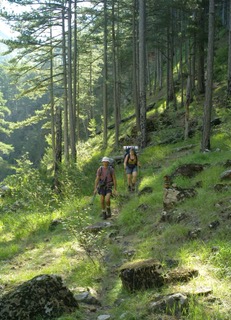 The Peloponnese and Pindos Way follows ancient footpaths from one end of Greece to the other: from the Albanian border in the north-west to the tip of the Peloponnese in the south-east, around 650km in total.
The Peloponnese and Pindos Way follows ancient footpaths from one end of Greece to the other: from the Albanian border in the north-west to the tip of the Peloponnese in the south-east, around 650km in total.
Both Pindos and Peloponnese are mountain routes. In the Pindos you are above 1000m most of the time and above 2000m some of the time. Parts of the route are reasonably provided with accommodation, but you do need to camp some of the time. The Peloponnese also climbs to 2000m in places but it does have gentler, low-level passages as well and is generally closer to civilisation and better maintained and waymarked. It is perhaps not as dramatic as the Pindos but it does have the advantage of board and lodging for every night of the fourteen days that it takes, bar one (and we offer some solutions for that). It also ends in the wonderful blue Aegean: an end devoutly to be wished! There are no technical difficulties in either part, but you do need to be fit and have some experience of hill-walking. We are working on improving the waymarking all the time.
Some people are wary of trekking in Greece because of the summer heat. But if you remember that the temperature drops 7º 0r 8º with every 1000m of height gain you can see that it is always a lot cooler in the mountains than by the sea.
As for the best times of year: spring is magical, with a wealth of wild flowers. It is well under way in April in the Peloponnese. In northern parts and at higher altitudes it comes in June and even July. Mid-May to mid-October is best for the Peloponnese, June to mid-October for the Pindos.
Mountains always need to be treated with respect, but one of the joys of the benign summer climate in Greece is sleeping out. Most of the time you do not even need a tent; a tarp or a bivvy bag is quite sufficient and gives you a view of the night sky, with its myriad of stars. In fact it is hard to get to sleep for watching the showers of shooting stars.
So, rucksacks on and head for the Peloponnese and Pindos Way and let’s get it established as truly one of the great walks of the world, as it was billed in John Cleare’s 1988 Trekking: Great Walks of the World.
